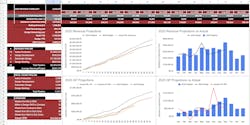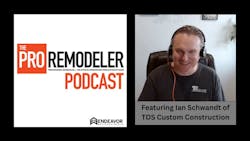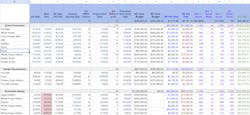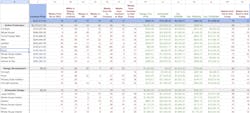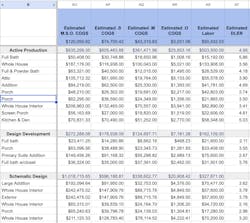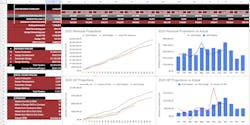The Big Board: A Living Spreadsheet That Predicts the Future
Key Highlights
- The Big Board acts as a living document that tracks every project phase, from design backlog to completion, providing a clear overview of progress and financial health.
- Key metrics like volume per week and the Direct Labor Efficiency Ratio help identify issues early, allowing for timely corrective actions.
- The Gantt chart and dashboard enable scheduling adjustments and financial forecasting, improving profitability and resource allocation.
- Regular updates and honest tracking of costs and revenues turn data into actionable insights, reducing reliance on instinct and guesswork.
- Using the Big Board fosters business resilience by providing foresight into potential downturns, enabling proactive management and strategic planning.
“I’m the guy who sits on the porch Sunday morning with a cup of coffee, f-ing around with a spreadsheet.”
That’s usually how I explain it when people ask what I do for fun—and for work. It’s kind of a running joke at this point, but it’s true. I like using data to build systems. And the spreadsheet I’m talking about—we call it the Big Board—isn’t just some hobby. It’s how we run the company.
Hear Ian Schwandt describe The Big Board on the Pro Remodeler Podcast.
The Big Board is a living document that tracks every project we have—from design backlog all the way through completion. It tells us what we’ve done, what we’re doing, and what’s coming next. But it’s more than a tracker. It’s the brain of the operation. It forces us to face reality and make decisions before the world makes them for us.
When people ask what it is, I usually tell them it’s the place where every project lives until it’s dead and buried. I have them listed by phase: completed jobs at the top, then active production, then pre-construction, design development, schematic design, and finally design backlog—the stuff we’ve sold but haven’t really started thinking about yet. As those projects move upward, the Board fills in their story: dates, costs, margins, crew load, all of it.
I like to think of it as a construction conveyor belt. A project starts in design, moves through development and pre-con, then rolls into production and gets built. The Big Board is how everyone at the company can see every project on that belt—where it is, how fast it’s moving, and what happens if one falls off.
Columns I through Y of the stats sheet, which feeds many of the dashboards and schedule tabs
The stats tab holds the raw information
Each row is a job. Each column is something I need to know. We track key dates—design agreement, design kickoff, schematic sign-off, contract signing, pre-con weeks, start date, substantial completion. Those let us measure how long things really take. When you know that, you can predict when a design job will hit the field and when it’ll start generating cash. That’s the whole point: to forecast what is around the corner.
I like to put the sheet up on a big screen TV and look at it from across the room. The green numbers are money. Red means I need to pay attention. You can see patterns that way. On a small screen it’s just a spreadsheet; on a big one it’s a heartbeat.
A lot of people collect data for the sake of it. The Big Board only tracks what influences decision making. The main one I look at is what I call volume per week—the total expected revenue of a project divided by how long we’re swinging hammers. It tells me how much revenue each week of production should generate. If a second-story addition normally produces twenty-three or twenty-four thousand a week and my new estimate says seventeen, that’s a red flag. Something’s off. Either we missed something in the estimate or we’re fooling ourselves about schedule. The ability to rough out a future project’s duration from just its top line revenue is one of the cornerstones of forecasting with the Big Board.
Columns Z through AN of the stats sheet, cover time and profit
Columns AO through AT of the stats sheet, quantifies various costs
I also look at what’s called the Direct Labor Efficiency Ratio. I stole that from an accountant named Greg Crabtree, who has written a couple of books I have read a couple of dozen times. DLER is how many dollars of gross profit one dollar of labor should create. It’s another honesty metric. If the ratio’s low, it means we’re overstaffed, underpriced, or both.
All of that comes from tracking cost of goods the right way—labor, subcontractors, materials, and “other,” like dumpsters or equipment rentals. When I can see those separately, I can spot what’s driving the change instead of guessing.
The Gantt chart is the key tab
The schedule view is where the Big Board gets its name. It’s a giant calendar that shows every job by phase. I can sit down with the project manager, the coordinator, and the leads and see exactly how the year stacks up. If the summer gets crowded, we start shifting things. Two small porches on the same street? I’ll put the same carpenter on both and get some economy of scale. Two kitchens across town? We’ll stagger them. Sometimes moving one start date by a week in June saves a month of headaches in October. That’s how we use the Board to make real-world decisions. It’s not about perfection; it’s about leveraging your options to improve profitability.
It's so big, it needs a widescreen. Ian looks at the big board Gantt chart on a widescreen monitor to put a year of work into view on one screen.
A dashboard pulls from stats for visual cues
The Dashboard tab is where it all comes together. It shows rolling six- and twelve-month revenue, gross profit, and labor hours. I can see how the pipeline compares to our budget and how both compare to our actuals. There’s a line for earned gross profit—the WIP number commercial contractors watch but most remodelers don’t. It keeps us honest about what we’ve billed versus what we’ve actually earned.
There’s also a labor-hours pipeline that tells me whether I can hire one of the new graduates from Madison College’s carpentry program each May or if we can fit in a small project during the mechanicals window of a larger project
Recently I built a gross profit-per-day calculator. Plug in your revenue target and margin, and it spits out how much GP you need to generate every day to stay on track. For us it’s around twenty-seven hundred dollars. If the Board shows twenty-three hundred, I don’t need to wait for a month end financials meeting to tell me something’s off—my team and I can look for ways to leverage our data and adjust schedules.
We run our daily work in JobTread. That’s where the budgets, bills, and timecards live. The Big Board sits next to it. Once a month I close out our work-in-progress accounting, make my WIP adjustments and copy over a few numbers. That’s enough. It doesn’t need to be fancy or automated. It just needs to be current and honest.
Foresight builds resilience and stability into the business
A former boss once told me, “This place costs me nine hundred thousand dollars a year just to turn the lights on.” He carried too much overhead, hit one bad job, and had to take out a nine-hundred-thousand-dollar line of credit. It was late and he didn’t make it. That stuck with me. When you run a business, you have employees and their families counting on you. I don’t ever want to find out in November that we’re looking slow in January. I want to see it coming in February. The Big Board gives us a runway to make corrections. It turns “oh no” into “okay, now what.”
It also keeps knowledge from disappearing. Our industry is in the early stages of generational change and when the old guard retires their institutional knowledge retires with them. Current generations operate differently. We want the tools to turn instinct into data and data into thoughtful action. That’s what the Big Board is.
I think a lot of remodelers have been lulled by good times of the last decade and a half. The phones ring, the leads flow, and it feels like everything’s fine. But when the phone stops ringing for six weeks, that illusion fades fast. The Big Board doesn’t stop downturns. It just lets us steer through them. When a half-million-dollar project disappears, I can see the hundred-thousand-dollar hole in gross profit and the thousand-hour hole in our production schedule immediately. Then I can shift jobs, raise margin on something else, or rearrange the schedule before it snowballs.
I see too many people running on instinct. That may have worked for the generation before me, but the industry’s more complex now. We have more moving parts, higher costs, tighter margins, and clients who expect precision. You can’t manage that out of your head anymore. Long term resilience requires that you see it in front of you. A spreadsheet can’t swing a hammer or sell a job, but it can help you do both of those things smarter. For me, the Big Board is part crystal ball and part insurance policy. It’s the one place where the past, present, and future all show up in the same frame—and it tells me the truth whether I want to hear it or not.
Building a Little Big Board
If you want to build your own version of this thing, don’t overthink it. You don’t need my thousand-hour monster; you just need something that tracks relevant data and tells you what’s coming, what’s happening, and what it’s costing you.
Start with one sheet. Put every project you have on it—signed, active, and still in design. Give each one a start date, an end date, and a rough number for total revenue and gross profit. That alone will tell you more than most software dashboards.
Next, figure out what you really want to see. What is a chokepoint in your system? For me it was project duration and volume per week was the stat that could be reverse engineered to provide duration for all projects – real and hypothetical. For you it might be labor hours, or cash collected, or backlog in months. Whatever it is, make the spreadsheet tell you that first.
Add columns as you need them, not before. If a number doesn’t change a decision, delete it. Keep the formulas simple enough that you can fix them without calling your bookkeeper.
Most important, look at it every week. You don’t have to be a data nerd. You just have to care about what the numbers are saying and be ok with it when they tell you that you are wrong. That’s the whole trick. The rest you’ll figure out on your own porch, with your own coffee, messing around with your own version of a Big Board.
About the Author
Ian Schwandt
Ian Schwandt is the production manager for TDS Custom Construction in Madison, Wisconsin.
